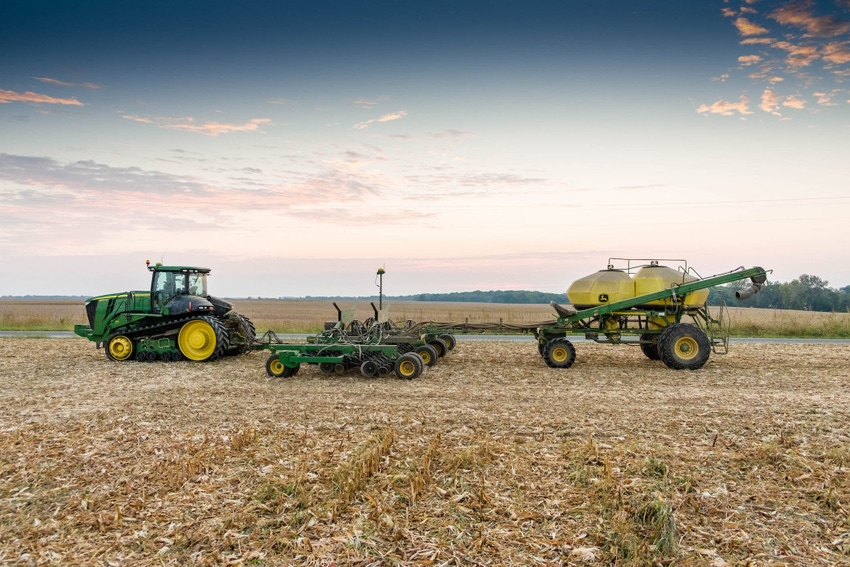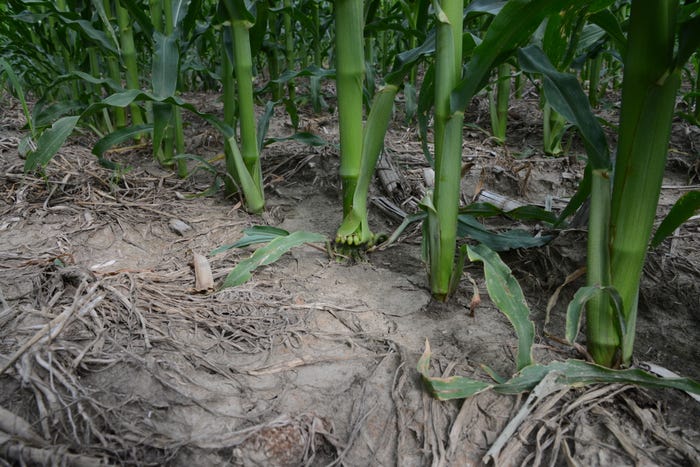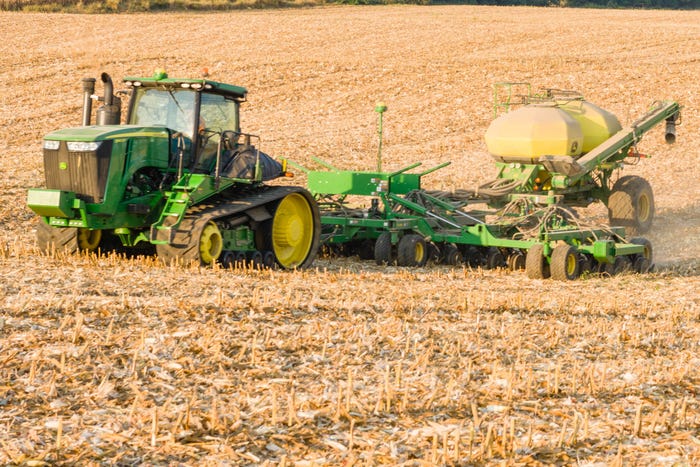April 27, 2018

-------
Think Different
Over the past six years, John and Dean Werries have learned a lot about cover crops:
· They are huge fans of annual ryegrass, a great choice for their area to seed in late September.
· They tried cereal rye for a few years, but that often worked too well, creating thick mats of vegetation that made planting a challenge.
· Cereal rye is a great weed suppressor that takes care of marestail.
· Since they started planting cover crops, corn yields hold a steady 25 bushels above county average, year after year.
· Cover crops held moisture that helped the 2017 crop perform in a hot, dry summer. On a 95-degree day, bare soil was 106 degrees but under cover crops it was 91.
· Cover crops almost eliminate erosion, sequester nutrients, help break up compaction better than any iron, and they add organic matter and general soil health.
-------
Illinois farmer John Werries gets so upset when he sees prime central Illinois topsoil blowing in the wind or running into ditches with spring rains.
This philosophy is probably due to growing up on his family farm and building a 3,800-acre operation on the legacy of his parents’ hard work as crop-share farmers in a free-rent shack near near Chapin during the Great Depression.

John and Dean Werries use cover crops to prevent erosion, capture nutrients and build soils on their operation near Chapin, Illinois. They have planted all their acreage to annual ryegrass cover crops in 2012 and haven’t looked back.
“This is my 53rd year of farming,” Werries says. “I’ve seen so much erosion in my life it’s sickening. Just this past May 15, it looked like the Dust Bowl here. On one field in our area, there was a cloud of dust coming off the field from noon ‘till 6:00 p.m. How many pounds of soil can blow off an acre on a day like that? How much of your time and energy do you want to spend fixing ditches? How much of your $11,000-an-acre dirt do you want to wash away?”
Werries had been no-tilling soybeans since the 1980s. In 1996, he switched to strip-till corn, keeping most of the soil surface protected from erosion and improving the quality of his soils. In 2011, after studying cover crops and attending grower meetings to learn more about them, he, his son Dean and a neighbor Andy Shireman decided to go all-in on cover crops, teaming up to buy an air seeder. They were so committed to the idea they figured they’d go into the cover crop seed business.
“We were wanting to get into it big-time,” says Werries. “We decided there was no cover crop dealer close to us, so we ought to become a dealer. I Googled cover crop seed dealers and called KB Seed Solutions in Oregon. Nick Bowers answered the phone. I said, ‘We’re interested in becoming a seed dealer. We want two semi loads of annual ryegrass.’ Bowers replied, ‘You are not sowing all your farm to cover crops the first year. You need to experiment with 40 acres.’ I replied, ‘Yeah we are.’ Bowers said ‘I don’t recommend it.’”
The Werries did it anyway—sowed every acre to cover crops in the fall of 2012 and every acre since.
Lessons learned
Over the past six years, John and Dean Werries have learned a lot about cover crops. They quickly became huge fans of annual ryegrass, a great choice for their area to seed in late September, while conditions are still warm enough for the ryegrass to establish a winter-hardy stand. They tried cereal rye for a few years, but that often worked too well, breaking dormancy early in the spring and creating thick mats of vegetation that made planting a challenge.
They also stopped planting radish after the massive top growth turned a field into a slick mess one wet fall. Part of the problem, notes Werries, was that the three-pound-per-acre seeding rate that had been recommended was far too thick. Radishes on compacted end rows completely choked out the annual ryegrass, he notes.
In 2017, they switched much of their late-seeded cover crop to triticale, which breaks dormancy later than cereal rye, a trait that should reduce the problem of rank growth, John Werries says. They lowered the seeding rate for triticale from what they’d used for cereal rye, seeding 25 pounds per acre ahead of soybeans and 20 pounds per acre before strip-tilled corn.

Cereal rye is great for controlling marestail, says John Werries, but he and his son Dean have switched to triticale and lower seeding rates to prevent thick mats of vegetation.
Despite the challenges of dealing with cereal rye, they also learned to respect one of its key benefits.
“Cereal rye is a great weed suppressor,” Werries says. “If you have a stand of cereal rye, you won’t have marestail. Period. Marestail is a real problem in this area for people who don’t till the soil, and you can’t kill it in the spring. You have to kill it in the fall.”
Better environment
Cover crops also held moisture that helped the 2017 crop perform better than the Werries expected after a hot, dry summer. John Werries figured he’d see 180-bushel-per-acre corn, but ended up with a whole-farm average of 206 bushels of corn and a 74-bushel average for beans.

A combination of annual ryegrass cover crop and strip-till yield the ideal balance for John and Dean Werries to create a great seedbed for corn—and protect it from erosion and nutrient loss.
“And we were in the driest of the dry last summer,” he says.
Werries attributes the surprising success in part to the moister, cooler environment beneath his cover crops. In addition to minimizing the loss of moisture from the soil, cover crops keep the soil significantly cooler.
“We measured soil temperatures on a 95-degree day,” Werries says. “Bare soil was 106 degrees. Under cover crops was 91.”
Add it to the list of benefits the Werries see in cover crops. Since they started planting cover crops, the Werries have seen their corn yields hold a steady 25 bushels above county average, year after year.
“Cover crops help almost eliminate erosion,” Werries says. “They sequester nutrients, help break up compaction better than any iron, and they add organic matter and general soil health. The soil supports equipment better.”
Nutrient management
Dean Werries says he and his father haven’t cut back on nitrogen applications after cover crops, which is something some other cover crop fans have done. At least not yet.
“We haven’t had the nerve to decrease the fertilizer too much, but there’s the extra activity in the soil—when we start doing that, that will be real dollars,” he says.
“We believe in sidedressing earlier than most,” Dean Werries points out. “The corn is two to three inches tall when we start. Part of it is logistics—we get it done a little earlier and we like not mashing the end rows when it’s tall. The little corn will spring back. The other part is that we’re carrying our plants until we get our nitrogen back from the cover crop—our plants probably need it before the cover crop is returning the nutrients.”

A clever, GPS-guided seeder setup John and Dean Werries built allows them to seed cover crops on either side of a clean strip for corn.
That early sidedress fits the Werries’ deep commitment to the 4Rs of Nutrient Stewardship, which call for the right source, applied at the right rate at the right time to the right place. Their annual nitrogen rate is about 1 lb./bu. of corn, but it is applied in as many as six passes to spoon-feed the crop. Thanks to their strip till practices and the ability of cover crops to sequester and transport nutrients throughout the soil profile, their P and K levels are excellent as deep as one foot below the surface.
“We don’t need to do banding, we don’t think we need to work it in, because we’ve got a good thing going,” says Dean Werries. “We don’t want to change that.”
Though Dean Werries has spent most of his farming career strip tilling with his father, he says he appreciates the primal tug of tillage. But he won’t trade their commitment to strip-till corn, no-till beans, and cover crops.
“Sometimes in the spring to drive past a freshly tilled field and smell that soil—I get it!” he says. “But this is the more responsible thing to do, to take care of the soil. Some people are working on quantifying how much good it’s doing. I think we’re seeing results.”
Strip till innovation
John Werries believes in strip till and he believes in cover crops. He also believes in finding ways to make them even more effective.
After grappling with runaway stands of cereal rye cover crops that overwhelmed his corn strips and buried his soybean fields in dense mats of vegetation, he and his son Dean decided to build a system that allows them to seed cover crops precisely between corn strips and drill beans between cover crop rows.
The key is sub-inch accuracy in steering the drill. John Werries took his existing John Deere 9000RT two-track tractor with a wide-swing drawbar and rigged it with an AJ Equipment steerable hitch. With an RTK receiver on the tractor, an RTK receiver on the drill, and John Deere’s iSteer, they now have active implement guidance—the implement receiver steers the drawbar, and the tractor and implement stay exactly on track.

Tying together an RTK-guided tractor, RTK-guided seeder, and a steerable hitch, John and Dean Werries created a system capable of seeding cover crops with a clean strip for corn and switching to solid-seeded covers for soybeans with the touch of a button.
They had to switch out the tow-between air cart so the drill would be directly behind the tractor, John Werries notes, replacing it with a 270-bushel, two-tank, tow-behind cart.
The Werries then removed 16 of the drill’s 64 row units, leaving 48 rows which they moved to 10-inch spacings. On the front tank’s meters, they opened four runs, which allowed them to skip every third row. That leaves the strip clear of cover crops, which are evenly spaced in two 10-inch rows to either side of the corn row. When it’s time to plant cover crops on next year’s soybean fields, a few keystrokes in the cab turns on the two back towers, which opens all six runs to allow solid sowing.
“It’s awesome,” John Werries says. “The strips look beautiful between the cover crop rows, and we are confident we can drill soybeans between the 10-inch rows of cover crops and not have to fight the covers.”
About the Author(s)
You May Also Like




